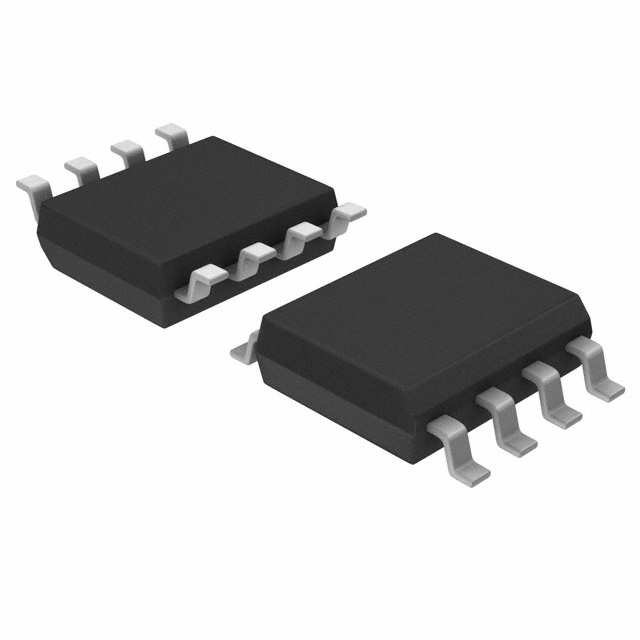Xem thông số kỹ thuật để biết chi tiết sản phẩm.

LM306DRG4
Product Overview
Category: Integrated Circuit (IC)
Use: The LM306DRG4 is a high-speed voltage comparator designed for use in various applications such as analog-to-digital converters, oscillators, and waveform generators.
Characteristics: - High-speed operation - Low input offset voltage - Wide supply voltage range - Rail-to-rail output swing - Low quiescent current
Package: The LM306DRG4 is available in an 8-pin SOIC (Small Outline Integrated Circuit) package.
Essence: The LM306DRG4 is an essential component in electronic circuits that require fast and accurate voltage comparison.
Packaging/Quantity: The LM306DRG4 is typically sold in reels of 2500 units.
Specifications
- Supply Voltage Range: 2V to 36V
- Input Offset Voltage: 2mV (maximum)
- Response Time: 1.3ns (typical)
- Quiescent Current: 500µA (maximum)
- Output Current: ±20mA
- Operating Temperature Range: -40°C to +85°C
Pin Configuration
The LM306DRG4 has the following pin configuration:
```
| | --| IN- OUT |-- --| IN+ VCC |-- --| GND NC |-- |___________| ```
Functional Features
- High-speed voltage comparison
- Rail-to-rail output swing allows for wide dynamic range
- Low input offset voltage ensures accurate comparisons
- Wide supply voltage range enables versatile applications
- Low quiescent current minimizes power consumption
Advantages and Disadvantages
Advantages: - High-speed operation suitable for time-critical applications - Wide supply voltage range accommodates various power sources - Rail-to-rail output swing provides flexibility in signal processing - Low input offset voltage ensures precise voltage comparison
Disadvantages: - Limited output current may restrict certain applications requiring higher drive capability - Sensitivity to noise and interference may affect performance in noisy environments
Working Principles
The LM306DRG4 operates based on the principle of voltage comparison. It compares the voltages at the IN+ and IN- inputs and produces a high or low output depending on the result. The comparator's high-speed operation allows for quick response times, making it suitable for time-critical applications.
Detailed Application Field Plans
The LM306DRG4 can be used in various applications, including:
Analog-to-Digital Converters (ADCs): The high-speed operation and accurate voltage comparison make the LM306DRG4 ideal for use in ADCs, ensuring precise conversion of analog signals into digital data.
Oscillators: The LM306DRG4 can be utilized in oscillator circuits to generate stable waveforms with fast rise and fall times.
Waveform Generators: Due to its high-speed operation and rail-to-rail output swing, the LM306DRG4 is suitable for generating various waveforms used in signal processing and communication systems.
Detailed and Complete Alternative Models
Some alternative models that offer similar functionality to the LM306DRG4 include:
LM311: This voltage comparator offers high-speed operation and a wide supply voltage range. It is available in various package options.
LM339: A quad voltage comparator with low power consumption and rail-to-rail output swing. It is commonly used in battery-powered applications.
LM393: This dual voltage comparator features low input offset voltage and a wide operating temperature range. It is available in small packages for space-constrained designs.
In conclusion, the LM306DRG4 is a high-speed voltage comparator with various applications in analog-to-digital converters, oscillators, and waveform generators. Its key features include high-speed operation, low input offset voltage, wide supply voltage range, and rail-to-rail output swing. While it has advantages such as precise voltage comparison and versatile use, it also has limitations in terms of output current and sensitivity to noise. The LM306DRG4's working principle is based on voltage comparison, allowing for quick response times. Alternative models like the LM311, LM339, and LM393 offer similar functionality and can be considered depending on specific requirements.
Liệt kê 10 câu hỏi và câu trả lời thường gặp liên quan đến ứng dụng LM306DRG4 trong giải pháp kỹ thuật
Sure! Here are 10 common questions and answers related to the application of LM306DRG4 in technical solutions:
Question: What is LM306DRG4?
Answer: LM306DRG4 is a high-speed voltage comparator integrated circuit (IC) that is commonly used in various technical applications.Question: What is the operating voltage range of LM306DRG4?
Answer: The operating voltage range of LM306DRG4 is typically between 5V and 30V.Question: What is the maximum output current of LM306DRG4?
Answer: The maximum output current of LM306DRG4 is typically around 20mA.Question: Can LM306DRG4 be used as a level shifter?
Answer: Yes, LM306DRG4 can be used as a level shifter to convert signals from one voltage level to another.Question: Is LM306DRG4 suitable for high-frequency applications?
Answer: Yes, LM306DRG4 is designed for high-speed operation and is suitable for high-frequency applications.Question: Does LM306DRG4 have built-in hysteresis?
Answer: No, LM306DRG4 does not have built-in hysteresis. External components may be required to add hysteresis if needed.Question: Can LM306DRG4 operate with a single power supply?
Answer: Yes, LM306DRG4 can operate with a single power supply, typically between 5V and 30V.Question: What is the input offset voltage of LM306DRG4?
Answer: The input offset voltage of LM306DRG4 is typically very low, around a few millivolts.Question: Can LM306DRG4 be used in automotive applications?
Answer: Yes, LM306DRG4 is qualified for automotive applications and can be used in automotive electronics.Question: What is the temperature range of LM306DRG4?
Answer: The temperature range of LM306DRG4 is typically between -40°C and 125°C, making it suitable for a wide range of environments.
Please note that the answers provided are general and may vary depending on specific datasheet specifications and application requirements.

